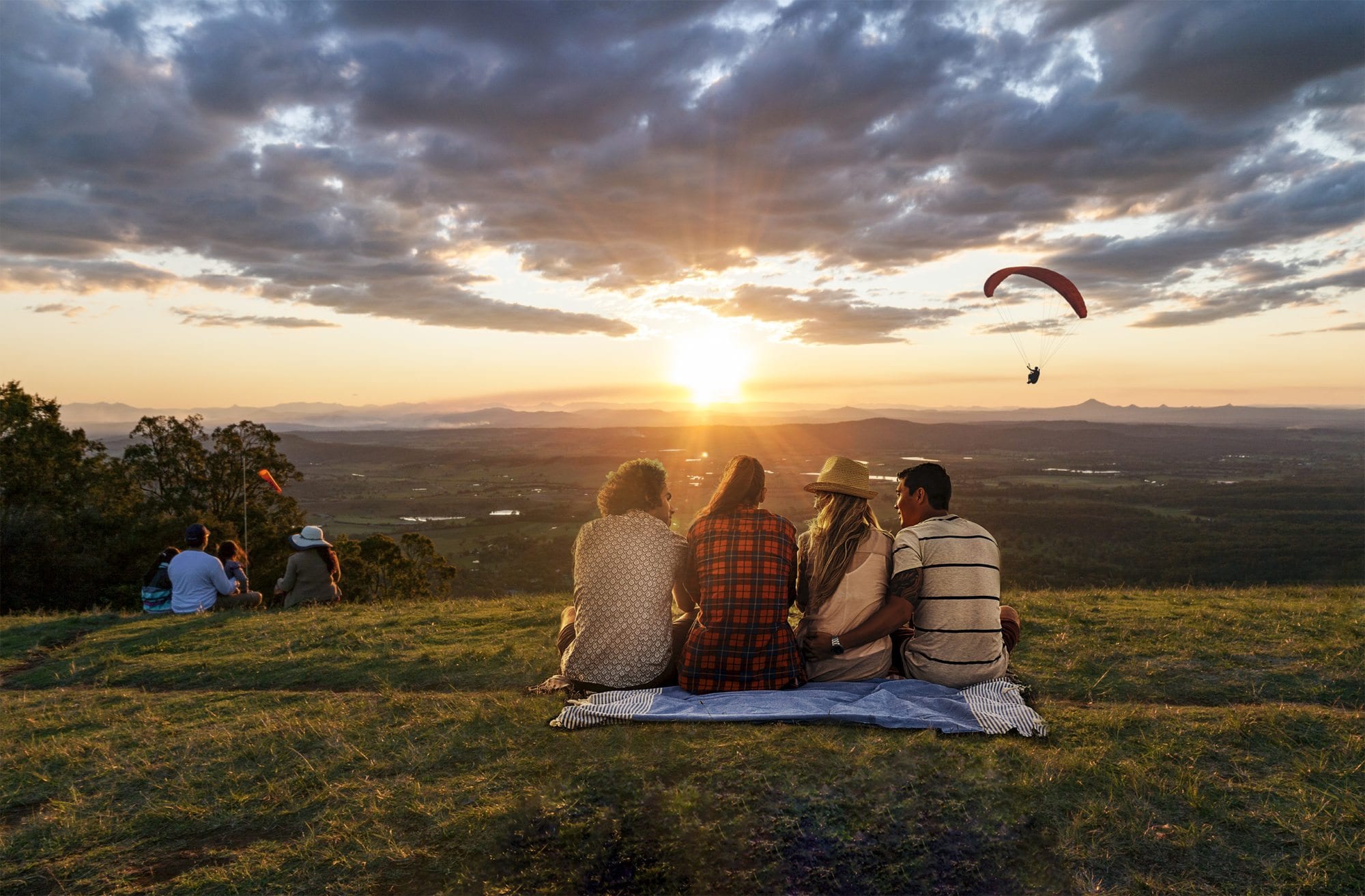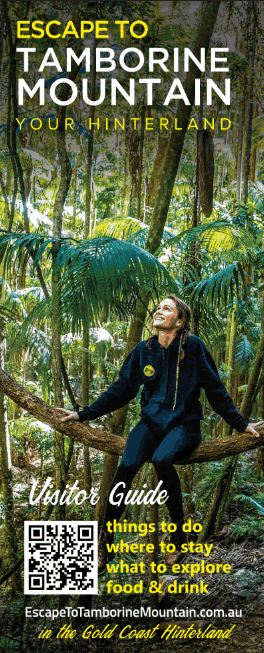
 Escape to Tamborine Mountain – Tourist Visitor Guide
Escape to Tamborine Mountain – Tourist Visitor Guide
Tamborine Mountain has its own Visitor Information Centre which is staffed by helpful and knowledgeable volunteers who can guide you to all things worth seeing and doing on Tamborine Mountain. You can pick up FREE MAPS to help you get around during your stay. There is also a range of displays of interesting aspects of the Mountain, as well as souvenirs and gifts.
For more info visit www.escapetotamborinemountain.com.au
About Tamborine Mountain
The Scenic Rim
Located 62 kilometres from Brisbane and sitting on the edge of the escarpment behind the city of the Gold Coast, Tamborine Mountain is both an actual geological phenomenon (the result of an outpouring of lava from Mount Warning) and also a collective term for a number of small villages stretching along the eight kilometre ridge of the mountain range.
The stunning increase in demand for property on’ the Mountain’ has occurred in part because Queensland prices have traditionally lagged behind those in other state capitals. Therefore, people selling in these areas can move to the Mountain and replace their home while keeping a tidy sum left over for investment. Nowadays many people are also seeking a ‘green change’ and find ‘the Mountain’ superbly matches this requirement. It offers a modern sanctuary from the hustle and bustle of city life, while being just 30 minutes from the Gold Coast and 1 hour from Brisbane.
The plateau of Tamborine Mountain is 550meters above sea level, 4 km wide and approximately 8km long. It has a subtropical climate, good rainfall, deep volcanic soils; the ideal conditions for the local flora and fauna to thrive. The residents of the Mountain do not have access to town water and each home uses tank water for household purposes and many use sub- surface water which is readily available.
The attractions of the district are the beautiful views which exist on both sides of the ranges, the number of rainforest areas with quiet streams and attractive waterfalls and the many craft and antique shops, galleries, wineries, tearooms and restaurants of the area’s villages which attract an artistically/craft-oriented community and a tourism focus. The rich volcanic soils also support a diversity of horticulture. Commercial crops include avocado, kiwifruit, avocado and macadamia nuts.
Tamborine Mountain is a volcanic plateau set within the Gold Coast Hinterland. From Tamborine Mountain you can get great views out over the splendid surrounding scenery, as well as out over the Gold Coast, to Brisbane and Mount Warning. You will also get the opportunity to see a range of wildlife including Lorikeets, Lyrebirds, Platypus, Scrub Turkeys and Wallabies.
There are some gorgeous waterfalls surrounding Tamborine Mountain, including the pretty Cameron Falls, Cedar Creek Falls and the Witches Falls. There are some amazing lookouts on the Mountain, offering stunning views over the Gold Coast and out over Canungra.
The beautiful Botanic Gardens are set on nine hectares, and located on Forsythia Drive, Eagle Heights, the Gardens are open 24 hours a day and entry is free.
If you enjoy walking then the 9 National Parks within the Tamborine Mountain region are the place to go. There are plenty of walking tracks leading through magnificent subtropical rainforest, with several picnic and BBQ areas. A number of wineries and vineyards are in the area for those that enjoy wine or would like to sample the local produce. Winery tours are also available.
There are a number of attractions around Tamborine Mountain, as well as several accommodation places. You can also visit one of the fabulous cafes, wineries or restaurants within the area as well as some of the unique art and craft galleries.
Tamborine Mountain also hosts the Tamborine Markets at the Showgrounds on the Main-Western Road. The Tamborine Markets are held on the second Sunday of every month and are worth a visit as is the school market on the last Sunday of every month in Long Rd.
Climate
Queensland is known as the Sunshine State of Australia. On Tamborine Mountain you can enjoy abundant sunshine without the heat and humidity that more northerly parts of Queensland sometimes have to endure.
A few very light frosts mark the winter season. Winter days usually dawn to clear blue skies.
The first part of summer is marked by warm clear days and spectacular evening thunderstorms in traditional tropical style. Sometime after Christmas the summer rains carried in from further north by the North-West Monsoon reach down to replenish the underground water supply that provides both garden and irrigation water for most of the area. Although the humidity can be relatively high during this latter part of summer, the temperatures are quite mild and you only realize how high the humidity must be when you see the Mountain mists – rolling in like huge breakers over the eastern escarpment as the sea breeze blows across in the late afternoon.
Wildlife
This small plateau is rich in animal and bird life. Bird feeding is a local hobby enjoyed by many residents. The most friendly and colourful birds are the parrots, especially the aptly named Rainbow Lorikeets. The beautiful red and green King Parrots, the pastel blue and yellow Pale Headed Rosellas and the red and purple Eastern Rosellas are all to be seen in most Mountain gardens. Magpies, Butcher Birds and the shy Whip Bird harmonize from daybreak until sundown.
The Brush Turkey inhabits the rainforest and home gardens. The hen Turkey is the perfect female liberationist. The male builds huge mounds of leaf mulch then she lays her eggs in the mound and walks away leaving him to manage the entire incubation process. Electricity wires have become ‘Possum Superhighways’. That ‘bump’ on your roof at night is not some burglar trying to invade, but simply a possum taking a short cut. Bandicoots, dainty Wallabies, even Koalas and various other small Australian natives all call this area home. Butterflies add passing colour throughout the Mountain and a wide variety of frogs, from large Green Tree Frogs to Dwarf Tree Frogs and frogs with iridescent green spots on their backs, welcome the summer rains with a cacophony of sound.
Schools
Kindergarten and preschool facilities are available as well as excellent private child care centres. One located close to the North Tamborine State School with the other close to St Bernards Junior school.
http://stbernrdss.eq.edu.au/wcmss/ + http://tambmounss.eq.edu.au/wcms/
2003 saw the first graduation of students who had entered Tamborine Mountain High School in year 7. It is now a fully independent school with its own Headmistress http://tamborinemtnshs.eq.edu.au/wcmss/
Tamborine Mountain College is a private, non-denominational high school located on Beacon Road.
The choice of schools off the mountain that offer a bus service are St Stephen College in Upper Coomera, Trinity Lutheran College (co-ed), St. Hilda’s Girls School, The Southport School (boys only) and the Aquinas College.
Facilities
There are a wide range of facilities on the mountain and some of these include the large new Tamborine Mountain Medical Centre, Ambulance station, physios, acupuncturists, dentists, two pharmacies, two bakeries, an IGA in North Tamborine and a Foodworks at Eagle Heights shopping centre, a large Mitre10, two butcheries, specialist veg shops, health food store, plenty of take-a-ways, coffee shops and restaurants as well as the famous Gallery Walk that attracts over a million visitors a year.
For more information on local attractions and businesses… visit Escape to Tamborine Mountain’s best visitor guide
